Marica as a space to talk about queerness, indigenaiety and liberation | Movimiento Maricas Bolivia (English)
14th August 2023This text is part of Anahí Saravia Herrera’s commission Embodying Resistance/Encuerpando Resistencia: unfinished reflections from the Bolivian territory – see the full commission with further interviews and texts here.
Movimiento Maricas Bolivia (MMB) is a project run by Edgar Soliz Guzmán and Roberto Condori, with twelve years of work behind them. MMB is a community-based LGBTIQ+ organisation made up of people who self-identify as indian-indigenous-cholas1 as well as maricas-machorras-travas-cuir2. It was founded in May 17, 2010 with the broadcasting of its first radio program called Soy Marica y Qué (2010 – 2010), broadcast through Radio Deseo in the city of La Paz. Subsequently, the program moved to the city of El Alto under the name Nación Marica (2016). In 2022, Movimiento Maricas Bolivia produced the audiovisual program and street interventions Nación Marica Callejera that has more than thirty-three programs recorded in public spaces across La Paz and El Alto, featuring thirty-three guests who reflect on social, political, sexual, and indigenous issues in the country. This program is broadcast through their Youtube Channel and is the only audiovisual program whose signature discursive approach and embodied identities are indigenous-chola, as well as marica-machorra-trava-cuir.
They are a collective and a movement working to bring an intersectional critical perspective to how we look at queerness, or rather what it means to be marica (roughly translated to faggot). Rather than taking on a global homogenized idea of what ‘gayness’ or ‘queerness’ is, they are working to build from their intersectional identities as Aimara, Quechua, working class, and queer, rejecting how terms that define and frame queer experience are imported and constructed by western standards. Instead, they claim the expansiveness of what being marica means, taking back the term used to insult LGBTQ+ folks and instead using it as a space to talk about ancestrality, queerness, indigeneity, and liberation.
Their work is multidisciplinary but hinges on the occupation of public space through their street interventions. They use the street as the ultimate space for democratic dialogue and often take key places around the cities of La Paz and El Alto to host conversations with referents from the LGBTQ+ community in Bolivia and beyond, alongside many performative actions. Rather than calling themselves artists or activists, they conceive themselves to be part of a movement that is working to be fiercely independent in a context that does so much to simultaneously empty and disempower independent organising by absorbing groups into NGOs and government bodies.
In 2022, they carried out Nación Marica, which looked to host a series of interventions along key dates in the calendar year, all of which define and shape how ‘national’ subjects are defined and what kind of homophobic and racist nationalist imaginaries are constructed through them. I met them in December of 2022 to talk about this work and their relationship to performativity, embodied politics, art, and activism.
As a part of our collaboration, they have allowed performingborders to translate one of their works into English for the first time. You can experience Desandar la Ciudad/ Unravelling the City HERE.
Note on translation and the final research:
As someone with access to both Spanish and English, this research has happened across both as well as through local dialects. The final works are edited versions of our conversations, which took place in Spanish with interjections in slang, Aimara and Quechua. The original version of this final text is in Spanglish, with my reflections in English. I have also provided a full English translation. The texts in Spanish were edited with the support of Camilla de la Parra, who also consulted on the translation.
See the Spanglish version of the text, with an untranslated conversation, HERE.
We began our conversation by talking about how MMB’s street interventions engage with public space rather than art spaces, and how they choose to move and make their work visible to the public, moving beyond what would normally be found in cultural institutions and their limited political reach.
Edgar: We don’t think of our actions only as artistic, why? Because we don’t have that artistic training, we don’t come from that field and [crucially], we’re not interested in entering artistic spaces or circuits… Our proposal, although some people might call it a performance, we think of as street interventions. When we make street interventions, we emphasise the political side of that intervention. The political perspective from the point of view of questioning power, a power that is patriarchal, heterosexual, white, upper class… […] Our actions and street interventions question precisely these hierarchies, and that is why it is political work for us. [To begin talking about our practice we would start there, defining what we are thinking through these interventions and clarifying our political premise of questioning the powers that be].
We don’t aim to enter artistic spaces because they are institutional, and spaces made for the upper classes. It could be interesting to open u [these spaces because we recognise ourselves as indigenous: I am Quechua, Roberto is Aimara and we have been working on intersectionality and transversality. However, we have always had a critical perspective when these spaces are opened up to us. There can be exoticization, [tokenization, and idealisation] of our proposals, in spaces that ultimately belong to the upper classes. Who goes to the art museum? Who goes to the exhibitions at the Centro Cultural de España? Who gets to enter these art circuits? The upper classes and those who have the privilege of being trained in these careers, understanding these processes, and reading artistic works as such. The people like us, the working classes, are not in these spaces. So that’s why we are interested in being in the street. We are interested in the street because I feel that the working classes are there, which is where we come from, and that’s why we don’t see our work solely as an artistic proposal. We propose it as a street intervention because we want the people who are in public space to be questioned and affected by what we do.
Our street interventions are not abstract, they don’t have to do with theories or concepts brought by the art world, always looking to the west for validation. Our work is not thought from that place, our interventions are]more concrete proposals [of political experiences]. It can be an intervention with a manifesto read through a megaphone, but we also always try to think of an action that interpellates and challenges others. And here, of course, there is a big discussion about whether art should be an instrument of social and political struggle or not. There are many people who defend art for art’s sake, but we are interested in these street interventions making people uncomfortable, making people question structures of power and destabilizing hegemonies. When we talk about hegemonies, we are also talking about the obligatory heterosexuality in which the working classes have been educated, so that’s why it’s very important to make these street interventions in the public space where the ordinary population can find them. […]
Public space itself is important for us because we start from the premise that all social spaces and, above all, public space is a space of heterosexual hegemony. Apart from the agendas present in the months of May and June, which grant certain permission to queer folks to carry out actions, marches and parades, […] nothing happens in public space the rest of the year. So for us, it is important to situate all of our work there.
The programmes we make (in reference to the interviews and programmes on their Youtube Channel), we conceive of as street interventions. We are occupying space with our dissident, transvestite, transformed bodies. We are occupying space with our discussions that have to do with the gremio marifrunci3 as we call it, which is the LGBTQI+ space, but we are also occupying a space that corresponds to us as inhabitants of this city. So, I think we should start there when we think about why our horizon is not the art world, I feel that there is a lot of work to be done in the art world to create or even open up space to ordinary people, to gente de a pie4 . […] And of course, it’s not just one space we want to occupy – it’s the street, it’s the square, it’s the market, it’s the fair, it’s La Paz, it’s El Alto5.
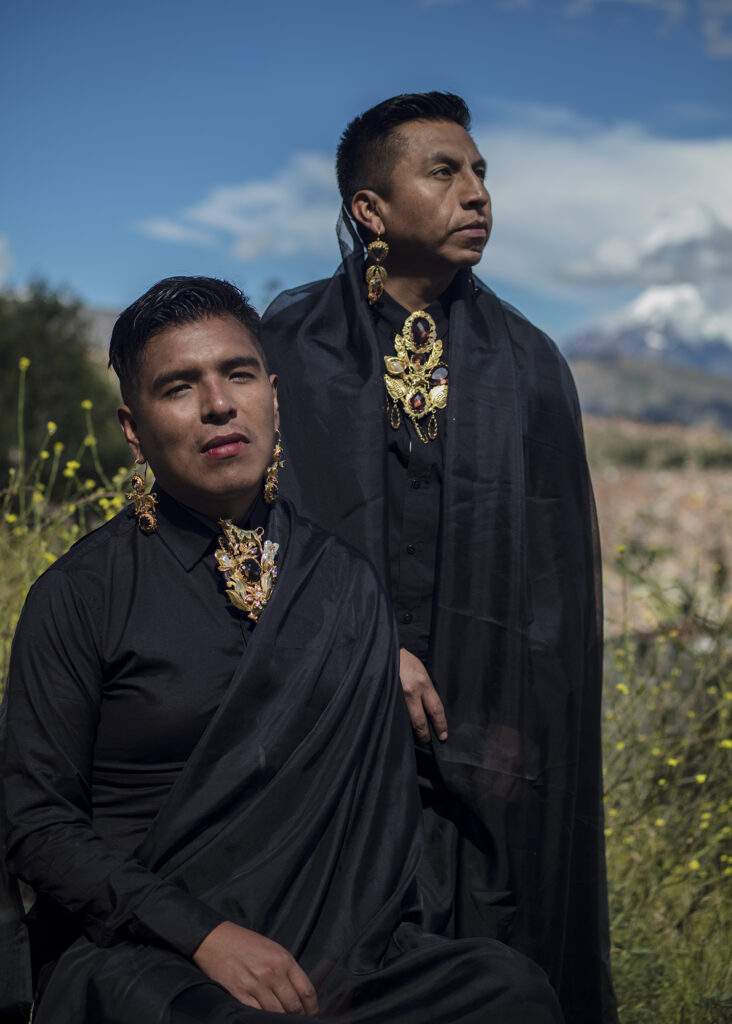
Roberto (left) and Edgar (right)
Anahí: When did you start with street interventions? Was that always your ‘methodology’ or approach to taking public space?
Roberto: The movement started with the radio programme Soy Marica y Qué on Radio Deseo. This, for me, was a period of maturation in my personal thinking. I wasn’t very into this “activism” thing and I didn’t have a lot of things to say, when I started. So I feel that the radio programme has been fundamental in this process of evolution of thought in order to be able to make the interventions we make now. The act of speaking in the first person has meant a lot to us because we were speaking for ourselves, so that others don’t speak on our behalf, right? […]
Edgar had said at some point that the radio programme untangled our tongues, and it is from the issues and topics that we addressed in the radio programme that other ideas began to come up as well. We thought, what could we do apart from addressing the topic in an interview format? Well, we could write something, we could make a manifesto, make an intervention. As a movement, our first intervention was on the 28th June at the Pride march, when we questioned the ideas around the ‘diversity and inclusion’ of LGBTQ rights that the mayor’s office was professing at the time. To get there, a precedent for our work was important and that was the radio programme. We had the radio programme for almost three years, and then we kind of realised that the next step was this on the streets.
This first intervention occurred because the municipal mayor’s office here in La Paz at that time was giving away school materials. In this material, there was a dictionary that defined the word “marica [faggot]” as a malicious man who harms others. Literally. […] We were indignant and we only [realised] because a friend of mine has a little brother and they had given him that dictionary. And in this moment, the mayor’s office professed inclusivity, that it was gay friendly. But there was a kind of double standard or hypocrisy, or maybe ignorance, on these issues. That’s why we decided to intervene in the march with a banner that said: “28 joto6 – sin discursos y con permiso para disfrazarse/ 28 joto – without speeches and with permission to dress up”, also questioning the activism of that moment, which works very closely to the municipalities and the authorities. That first intervention was framed thanks to the radio programmes, because that’s where we started to mature politically.
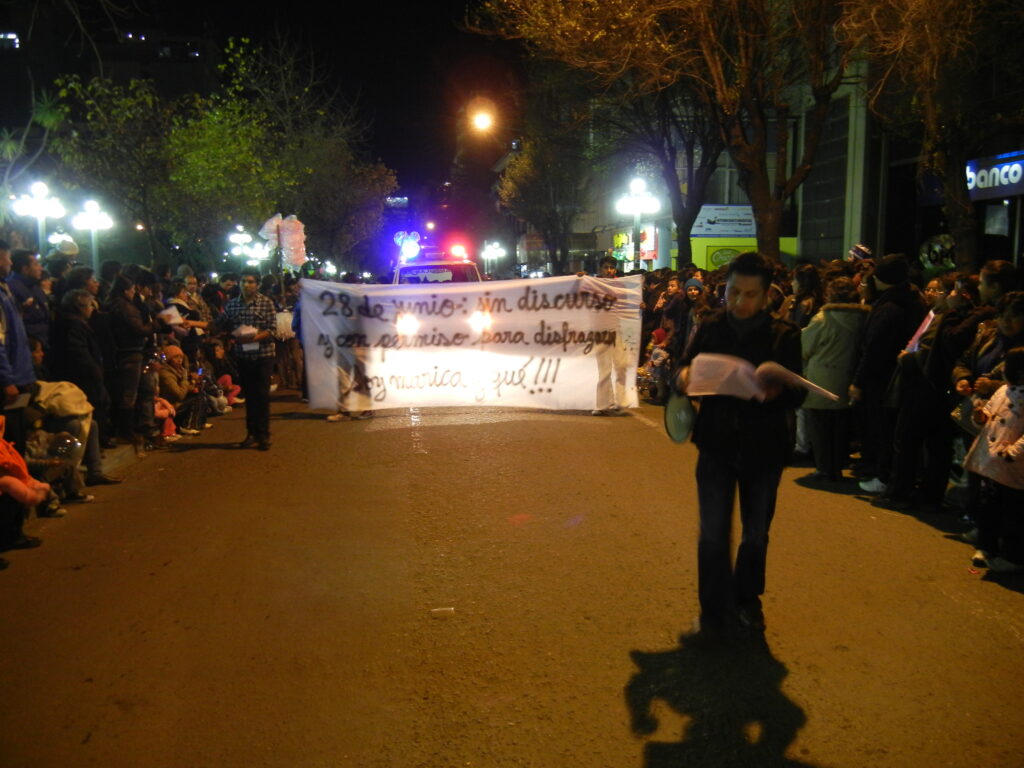
Anahí: How did you manage the radio programme?
Roberto:[…] By working with Radio Deseo in some ways we were supported and protected by Mujeres Creando7, beyond the fact that it was a free resource, it was a kind of complicity with the feminist movement. Once we left, we started to think about how we could sustain the project, what we could do to continue this work. And that’s where we’ve had several conflicts. We’ve had big pauses, perhaps because of the issue of sustainability, ultimately somehow making the project sustainable has fallen to the bottom of our priorities though. For example, this year’s Nación Marica was done without resources, just with what we had. We were able to sustain these programmes for up to half a year and then some organisations have come along who were able to provide funds to the project and have given sustainability to the proposal. So the ability to have sustainability in the projects and in the things we do, has become secondary. At some primary moment our need to say what we want to say and our anger have been our main motivation… whether it is sustainable or not, is a question that comes afterwards, when we ask – Now, how do we do this?
Edgar: DIY – Pure and simple self-production. […]
The radio was a training space in the political sense of the word. I wasn’t in the first team, I joined about a year later. But I understand that the MMB group had talks with María Galindo, they began to read Pedro Lemebel, they began to read other referents in the movement…
It has been an important learning space, because it has allowed us to somehow understand ourselves and [understand] that gay is a neo-colonial category for us tercermundistas8, who are neither white, nor young, nor beautiful, nor living in hegemonic bodies – which is what the word ‘gay’ means. We are subaltern subjects, marginal, fat, old, HIV positive – we are everything that is not gay. […] When one assumes oneself to be homosexual or gay, one is also assuming all that neo-colonial burden that is always, unfortunately, installed by the Global North in South American countries. It was from this formative space that we began to understand marica, first as a political proposal of resignifying the insult but also as a proposal of becoming (as Néstor Perlongher, an Argentinean marica, puts it) and of thinking of identities in the plural, not as a closed and defined one, but as one in constant becoming.
This has allowed us to understand that, as maricas, we are also workers, HIV-positive students, old, everything that is not gay. Marica has allowed us to generate an identity situated in our locality in order to understand this type of sexual dissidence. Of course, it is a proposal that challenges the gay world, because gay as a hegemonic and homogenous category is installed not only in Bolivia but also in Latin America, as the only possibility of naming oneself as homosexual. We are doing the opposite exercise. And that, of course, led us to Pedro Lemebel, Néstor Perlongher, Reinaldo Arenas, but especially Pedro Lemebel and to Las Yeguas del Apocalipsis9, whose work at the time they did not label as activism in the eighties in Chile. That term is very 21st century. So, getting to Las Yeguas del Apocalipsis, understanding their political proposal through La convulsión coliza and la loca, and how their work crossed paths with other types of street actions, has allowed us to understand that our proposal, although radio-based could also use this type of action, or call itself performance… whatever you want to call it.
Roberto: Our works are unrepeatable. Do you remember, Edgar in one of our interventions, a comrade from Cochabamba, Wilmer, said: “Come with your march to Cochabamba?” (They laugh) As if it were something that could be repeated, many people think that about the interventions we do, the media still ask us: “Come with your aguayos10 to kiss each other…”.
(Here making reference to their intervention, Desandar la Ciudad/ Unravelling the City – in which they move around key historic sites in La Paz, wearing aguayos and being intimate.)
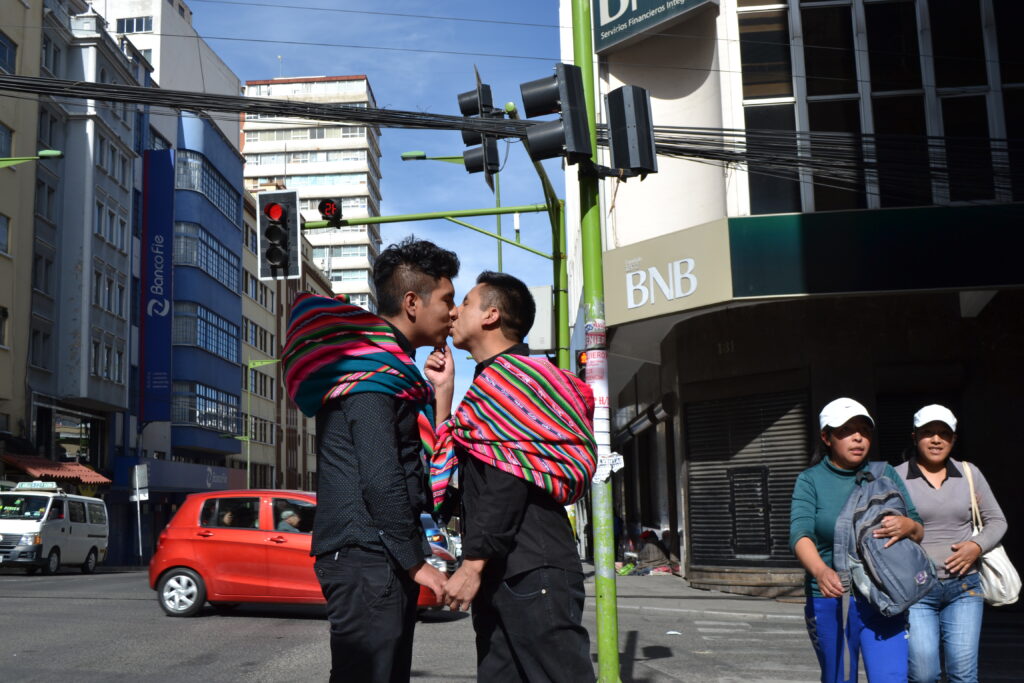
Anahí: I suppose they liken it to a work of art that you can make and remake.
Roberto: It’s an intervention, once it happens it doesn’t happen again!
Their practice of mixing political theory with action and embodiment comes from a method made from assembly contexts and encounters with others in the struggle. Their radio space as well as being a show to produce, was a space of collective learning.
Roberto: To do the radio programme, we didn’t just go and talk, but there were previous reflections with the group on the issues we raised. We would meet, we would talk, we would have a debate to reflect on our own experiences. It was healing too, at the time.
Anahí: It sounds like something similar to an assembly.
Roberto: Exactly. From all those reflections, we came up with our questions, the focus we were going to give them, who we were going to invite to discuss them. And this is a dynamic we have maintained until now, with Nación Marica, in every programme we have, we meet, we talk and we see what comes out of it.
Edgar: […] What we now understand to be intersectional, we began to understand on Radio Deseo, and not just us but this happened alongside [others who were in the radio space at the time], domestic workers, animal activists, chefs… There were several collectives in that radio space that had their own programmes and the ones we were most in tune with were the domestic workers. We understood each other because we came from almost the same social contexts. We could read each other in our indigeneity.
Speaking to a wider network of collaboration, Edgar and Roberto also spoke about the importance of weaving transnational connections to queer movements across Abya Yala11, not just because networks of solidarity are how they develop the politics they are building, working on the shared oppressions across the different territories, but because Bolivia’s involvement in these discussions is often minimised or excluded on a wider global stage. What does it mean to speak from a specific territory, and how can one do this whilst avoiding nationalist tropes?
Edgar: It is through Pedro Lemebel that we came to street interventions, or performance (for some), Lemebel and Las Yeguas del Apocalipsis have been important and enigmatic. They must study us in England, right? Latin American performance…
I have a very nice book recommendation: Perder la forma humana. Una imagen sísmica de los años ochenta en América Latina12 brings together artistic actions and street performances [in Latin America], and categorises them by different themes. I’m very struck by this book because it is thinking about Latin America from the arts throughout the 80’s, a decade full of conflict in which Latin America was, in general, going through dictatorships or emerging from them. But in this book, there is no Bolivia.
It bothers me a lot that Bolivia is always absent from these projects. We’ve just seen another one, Multitud Marica, a proposal by some compañeras we know in Chile, the CUDS (Colectivo Universitario de Disidencia Sexual) where there are several academics, artists and queers. The project thinks through the politicisation of the word marica in the activist and artistic sphere in Latin America. There is Peru, Chile, Argentina, Brazil, but there is no Bolivia. So I say again, Bolivia is the great absentee precisely in these activist artistic movements.
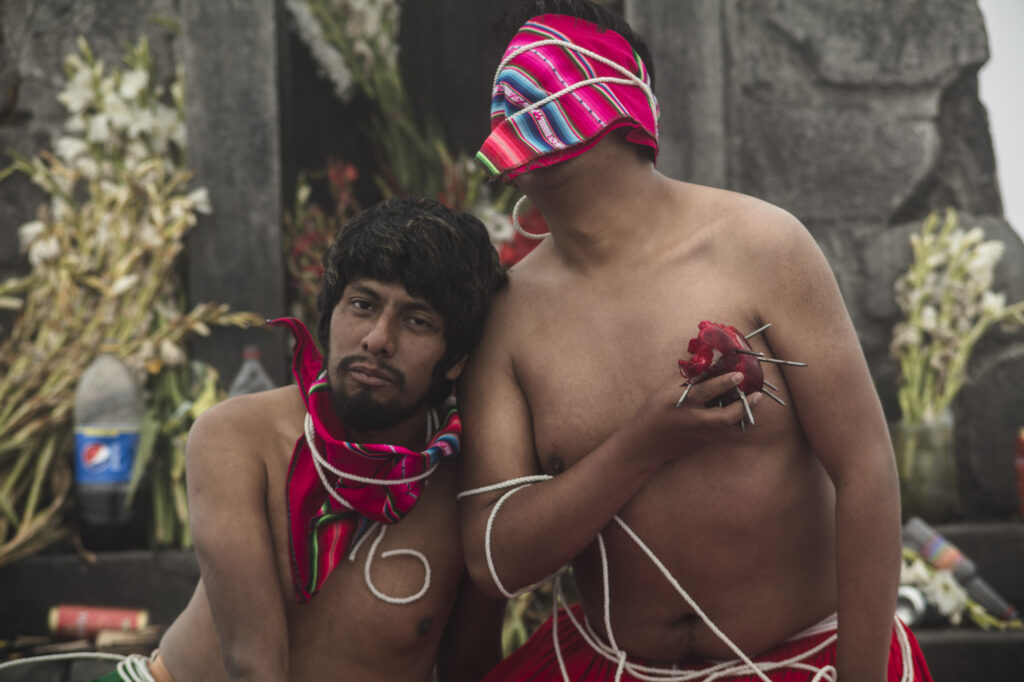
Anahí: I suppose your collaborations in Latin America are also driven by that, aren’t they? I mean, you want to bring your work to different spaces but also make clear that there is a lot of work being done here in Bolivia, about the same themes.
Edgar: When I say “there is no Bolivia”, or that we don’t exist for anyone…
Roberto: Or that we haven’t been invited!
(They laugh)
Edgar: It’s not necessarily us. In other words, there are other kinds of proposals that cross activism with art here. […] There are other works that are also not being recorded and that’s why Bolivia is the great absentee. Now, I don’t want to defend a nationality either, I just feel that there is a lot of valuable work in Bolivia that is not taken into account when it comes to studying activism and art.
In relation to our collaborations, we are always interested in the margins. For example, if we are activists, we are neither institutional nor official activists. We do not represent either the TLGB Collective13 or COLIBOL LGBT14. We do not come from those institutional groups that steal the representation of the LGBT population in Bolivia. Why? Because we situate ourselves precisely in a marginal place. We are building a proposal that is not only queer, but also indigenous, chola, Aimara, Quechua, decolonial. Everything that is not gay (as explained previously), is this project.
For instance, in Argentina, there is an artist called Bartolina Xixa, an artist and activist who has toured and reached many interesting spaces and we are very interested in her proposal. We met at a poetry festival, at the first Festival de Poesia Sudaka. I feel that in this journey, in this kind of construction of our queer political proposal that crosses several other disciplines, we meet with people who are also raising similar questions. Bartolina comes from the north of Argentina, from Tilcara, which is not Buenos Aires. So we’re very interested in her proposal because it’s very close to Bolivia, but because she’s also raising the issue of classicism and racism in the LGBTQ+ environment from her own understanding. She is [recovering] the word ‘marrón/ brown’ with a collective, Identidad Marrón15, which today is very strong in Buenos Aires and in the north.
I feel that border and peripheral spaces are always being thought of and from politically. Politically, always in the sense of questioning power, at least more than the ‘central’ or ‘normative’ spaces. That’s why we are interested in being on the margins, to put forward thinking from this place and to remind ourselves that not everything can go hand in hand with power.
The same in Chile, with Seba Calfuqueo, with whom we did a radio programme a year ago. We are very interested in the proposal they have been working on from their Mapuche identity and the reflections on names of ancestral or pre-Hispanic dissident sexualities. Which, of course, are not ‘gay’, ‘queer’, or ‘LGBT’. We met Calfuqueo when they were recovering the “weye“16, from Mapuche. […] We found ourselves in a discussion about the need to reclaim ourselves as indigenous, about the need to name ourselves from these pre-hispanic sexualities, which is not to be ‘gay’ which is quite neo-colonial.
With Peru, the same thing, we have been in relation with Maricas Peru, which is an interesting collective, based in Puno, which is very close to Bolivia. We did a book presentation in a hairdressing salon. This was about leaving hegemonic spaces and hosting the presentation at a salon, which is also a very political space for queers, for travas17, etcetera.
So, situating these discussions there, to find ourselves in a tejido Sudaca18, in a fabric of Abya Yala that allows us to think about our names, our indigenous, chola identities, but also about our sexual dissidence within our indigeneity, right? Because there is also a lot of conservatism and moralism in indigeneity – tampoco es una una taza de leche19, ¿no?

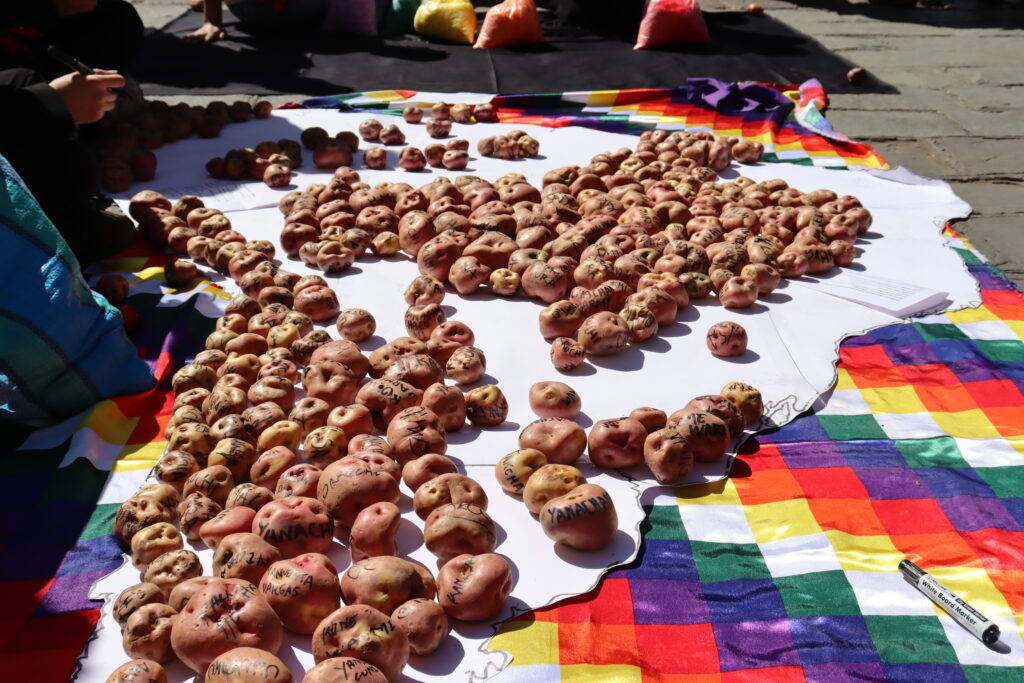
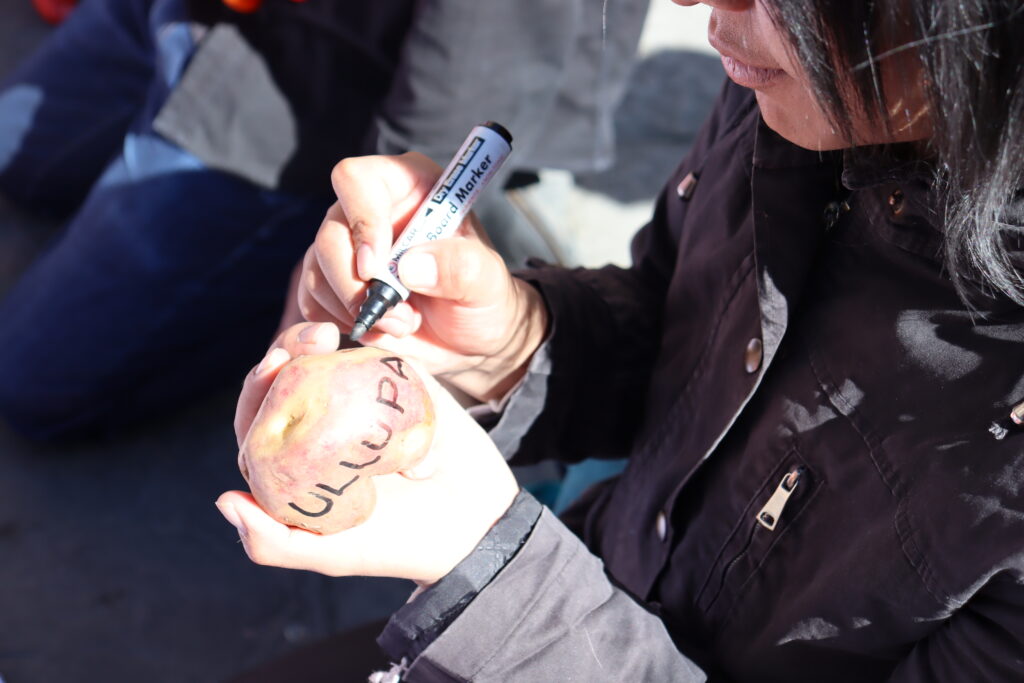
Thinking to how their work and their collaboration with other LGBTQ+ artists and activists relates to the broader leftist movement in Bolivia, both Edgar and Roberto commented on how conversations about gender, sexuality, sexual dissidence, and LGBTQ+ struggle, alongside conversations about feminism, continue to be missing from most leftist and indigenous-led spaces in Bolivia, something that is being intervened by a few organising groups such as Pan y Rosas and of course, Mujeres Creando. Talking about how their struggle relates to the current so-called “socialist” government Movimiento al Socialismo (MAS), which they do not believe to function in a socialist or leftist way, they said:
Edgar: I think that when MAS presents itself as a left-wing social movement and they position the LGBT issue on their agenda, they are taking demagogic action. They are presenting themselves as inclusive. It is precisely in these administrations that several laws have been achieved in favour of the LGBT population which, in our opinion, really has been the struggle of LGBT comrades and not the government. None of the articles, laws, or changes in policy that have been achieved […] have been free or easily ceded by the governments in power, especially not by MAS. These struggles have always been fought for by the LGBT population. But MAS, of course, appropriates this struggle to present itself as an inclusive left-wing movement. Why? Because within spaces that hold the most power in the MAS government, misogynist, sexist, homophobic, and transphobic practices are reproduced. Evo20 himself, as Indigenous as he is, is quite homophobic and his statements have shown it. Now, the LGBT movement, which is above all institutionalized in Bolivia, works to lobby and do logistics with those in power to achieve changes in policy which, unfortunately, is a necessary approach to make these changes […] But I feel that it is also necessary to permanently question these relationships, precisely because when you shake hands with those in power, it is always something that can be played against you.
Whilst their practice sits firmly within street interventions and their focus is on the interactions that take place in public space, an undeniable part of their practice lies within video documentation, an element that is particularly interesting for performingborders, as the space that is occupied by documentation and performance speaks to a wider practice of performances to camera.
Anahí: I have noticed that within your street interventions, documentation is almost as important as the intervention itself. Documentation is intentional.
Roberto: I was just saying to Edgar, when we did the Sodoma MIA interventions, [where] I was in charge of recording. My conflict was: “Do I document this, just for the sake of documenting or do I produce a work for our channels? If I did the latter, I had to be close to the artist and interrupt the whole performance, my presence there was very invasive… and in that specific case, this is what I did. Maybe the people who were watching wanted to observe and I was there, wanting to get the shot, and that’s when I began to question what we were doing this for, what the goal is, is it to demonstrate this for people [who aren’t there] or to be outside and record as much as possible? In some interventions, we’ve decided to work more on the audio-visual stuff so that a Youtube video is produced, always trying not to be too invasive. If there are people who want to watch, being careful not to interrupt.
But some interventions people don’t care about. They’re there only for a moment, looking out of the corner of their eye. In those cases, I kind of give myself permission to take more shots, thinking that through Youtube we could have more reach than at the moment of the intervention itself, despite the fact that in the street there will be people watching and passing by, but in some cases, this doesn’t work very well because people don’t come together to watch, they’re only there for a second and then they go away. In some of the interventions, yes they audience kind of comes together, they look and they spectate, and that’s where I say: I’d better be careful and not interrupt. I’ve thought about both scenarios.
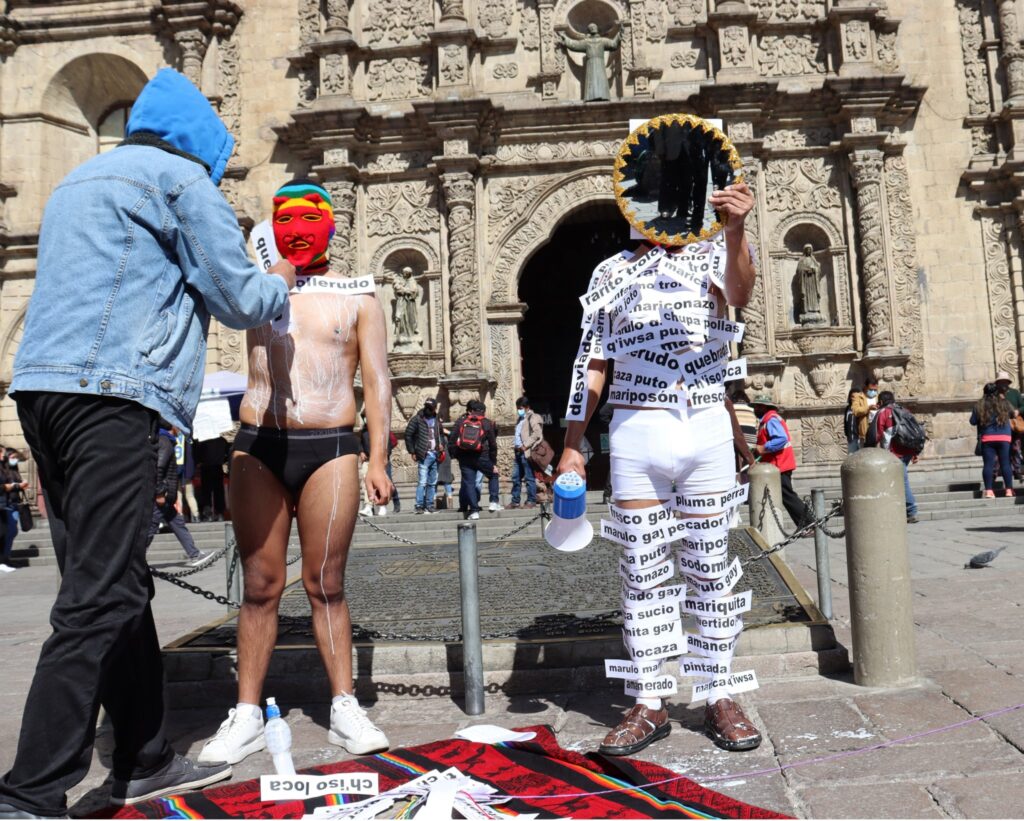
Anahí: I imagine that for this reason, depending on how people find your work, they might also think that you are audiovisual artists, right? Seba Clafuqueo is a good example because in their work they make interventions or performances, but they are also an audiovisual artist, because they create their own videos and images. What you are also describing is really an audiovisual artist practice, isn’t it? I’m very interested because your work exists both on the streets and online. Although the interventions are very street-based, they have that very important duality.
Edgar: I know when one says performances, you’re talking about an action that happens only once, that doesn’t have a script and generally might also have a kind of recording. It’s not a meticulous record with precise shots, it’s a camera and the performance artist does what she wants. Thinking through this [definition], the idea behind our work is that it’s not a performance, it’s a street intervention. And as a street intervention, at least this year in Nación Marica what we have worked on are specific dates… It was clear that between the 17th of May and the 28th of June, our proposal had to be decolonial, in recognition of our indigenous identities. It had to talk about classicism, about racism within the TLGB, etcetera. And on some other dates, such as the 6 August 21, the interventions had to think about how the national is being constructed […] All these emblematic dates somehow construct a national subject, don’t they? And in this construction of the national subject, there is a classist, racist, homolesbotransphobic hedgemony. So, that’s where our proposal comes from, as a critical space to dismantle these hegemonies.
When we think about every intervention, it has to be in the public space, because if it were only artistic, it wouldn’t work. In the public space, there has to be a concrete action and there is also a reaction from people. On the 6th of August in San Francisco, we were dragging the Bolivian flag and people threatened us. There were guys telling us: “Hey, what are you doing? Hey dipshit, you don’t use the flag like that! We’re going to hit you!”. And of course, we had to leave after a while. I told them: “This is an artistic action”. But of course, people don’t understand. There are things like that which are sacred to people. And one of those themes is precisely the national and patriotic symbols, isn’t it? The other is religion, too, especially the catholic church. For us, public space is interesting because that’s where all this happens. Anything can happen. […]
There is also a population on our social media and digital channels. One is the population on the street,[…] the one that looks, the one that questions, the one that is indifferent, the one that insults you, it is that population that interests us. That’s why our actions are in public space. The other population that we can’t ignore is the one that is now on social networks and virtual platforms. That’s why at some point I said to Roberto: We need to have a well-edited documentation of what we do, to offer an artistic product for that population that is online, which we also reach, very few of them, but we seem reach them anyway!
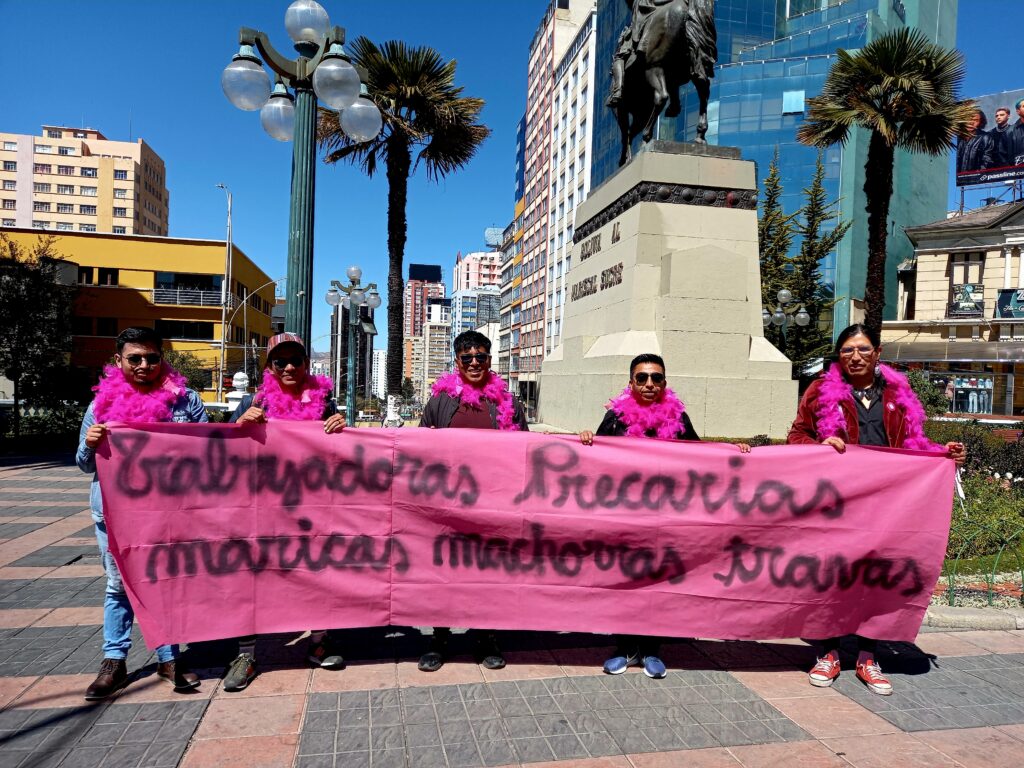
And finally, we arrive at the always dreaded question for many of those working at the intersections of creative work, struggle, activism, work, anger, and joy.
Anahí: Do you identify yourselves as artists?
Edgar: I don’t.
Roberto: I have a certain reticence about art, even though some of the things we do are art, inevitably that is something we are doing, but I wouldn’t define myself as an artist.
Anahí: How would you define yourselves and what is your practice?
Edgar: Workers. At some point we said: We are the laborers of communication.
The category of artist is very interesting because you can define yourself as an artist, but you go to an art space, and who are you? […] No matter how self-taught and famous you are, you are not an artist for that art circuit. In the eyes of the population, you can call yourself an artist and the population may believe you, or not, but the category of artist is very problematic, because it also has to do with understanding the processes of the sector and it’s history, doesn’t it? And as I was saying, we don’t have that training. At some point, we said that because a lot of what we do is taking-apart and setting up equiptment on the streets (which is is hard work because you have to carry tables, chairs etc), that we are the labourers of communication.
Roberto: We are the proletariat of art.
Edgar: The category of artist feels very elitist, I have a lot of conflict with that.
Roberto: Even though we make art in a way, don’t we?
Edgar: There are people who read it from that place.
Roberto: How else would you read it?
Anahí: Activism? Do you define yourselves as activists?
Edgar: It’s also another category we’re not sure about… (laughs)
Roberto: We’re so uncomfortable with everything!
Edgar: Artivism, which has become very fashionable, is a very NGO category. I feel that it minimises ‘artistic’ practices and very simplistically places them in defense of human rights, feminism, LGBT issues… What we do, although it is from this dissident marica perspective, is also indigenous, Aimara, Quechua, peripheral, subaltern, and crosses many other identity and non-identity categories. Artivism is art made by LGBTs for LGBTs in defense of human rights, and what we are doing is not just that either. I feel that what we are doing is broader than that. We are holding discussions that have to do with how the national subject is constructed in this country. We talk about the issue of death. We talk about HIV. We talk about decolonisation. So I feel that we are involved in other bigger discussions, so we would be neither artists nor artivists.
Roberto: Nor activists. Undefined, or maybe just maricas.
Speaking to the future of their work, whilst they are still thinking about the potential of their practice, they’re certain that what they don’t want is to be coopted by NGOs. They are not interested in comfortable governmental jobs, galleries, or cultural capital. They’ve resisted institutionalization for 12 years and plan to remain critical and independent, focusing on weaving a fabric of Sudaca solidarity in Abya Yala – stating:
The horizon of our struggle is the struggle itself. The permanent struggle.
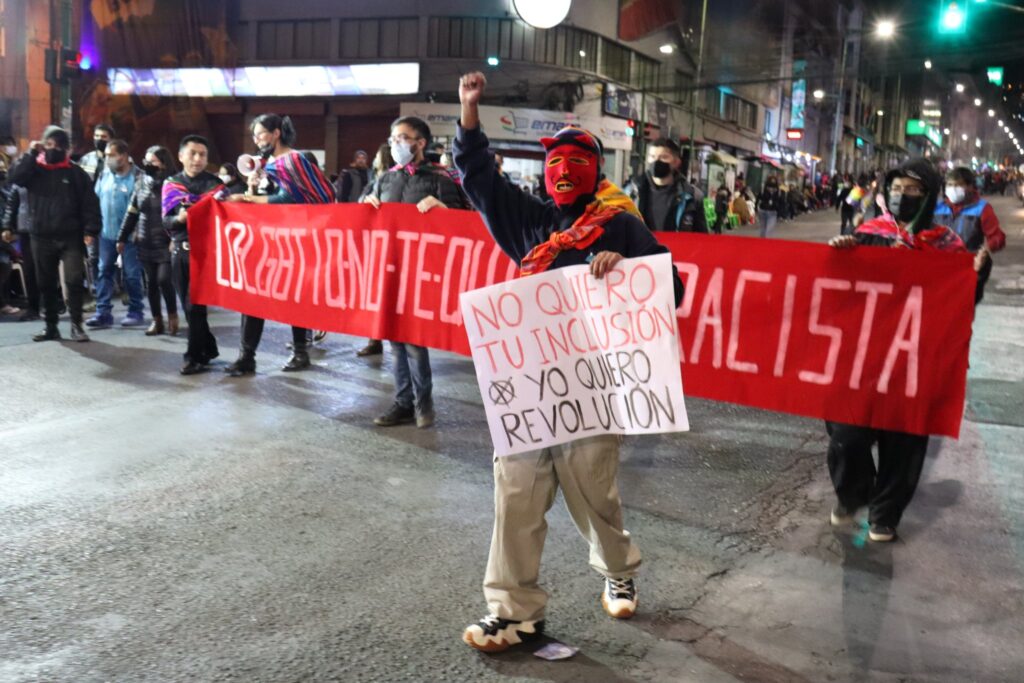
Movimiento Maricas Bolivia is a community-based LGBTIQ+ organisation made up of people who self-identify as indian-indigenous-cholas as well as maricas-machorras-travas-cuir. It was founded in May 17, 2010 with the broadcasting of its first radio program called Soy Marica y Qué (2010 – 2010), broadcast through Radio Deseo in the city of La Paz. Subsequently, the program moved to the city of El Alto under the name Nación Marica (2016). In 2022, Movimiento Maricas Bolivia produced the audiovisual program and street interventions Nación Marica Callejera that has more than thirty-three programs recorded in public spaces across La Paz and El Alto, featuring thirty-three guests who reflect on social, political, sexual, and indigenous issues in the country. This program is broadcast through their Youtube Channel and is the only audiovisual program whose signature discursive approach and embodied identities are indigenous-chola, as well as marica-machorra-trava-cuir. Nación Marica has received the “Periodismo en Derechos Humanos” award (2016 and 2017) from Católicas por el Derecho a Decidir for the radio reports Nuestra venganza es ser felices: historias de amor y resistencia política homosexual (Joy is our revenge: love stories and queer political resistance) and Morir por ser mujer trans en Bolivia: Dayana Kenia, una historia tan lejos de la justicia (Dying for being a trans woman in Bolivia: Dayana Kenia a story far away from justice. They have also received the “Periodista Sin Riesgo” award (2018) from Católicas por el Derecho a Decidir and Alianza por la Solidaridad for the radio report ¿Abortan todas, abortan las lesbianas? Situación del aborto en Bolivia desde una mirada lésbica. (Do all women abort? Do lesbians abort? Abortion in Bolivia from a lesbian perspective.) IG:maricas_bolivia, maricasbolivia.wordpress.com
Picture credit: La piel que co habito, May 2022, Movimiento Maricas Bolivia
1 Chola, is a term used for an indigenous woman in Bolivia (and neighbouring Andean regions), one who usually wears traditional clothes. It is a term that can be used in a derogatory manner, with racist tones but in this context is being reappropriatedted.
2 Roughly translates to faggots-dykes-trans-queers, it is important to keep these in Spanish throughout because, in part, the work of Movimiento Maricas Bolivia looks to explode and explore the locality of each of these experiences, which are untranslatable and are defined by class as well as through their positionality in the global south.
3 Marifrunci is a term used by Pedro Lemebel in their written work, where they use language to explode and subvert words used to speak derogatorily about queer folks, creating a new language for this community of people to tell their stories. Marifrunci is the term created for the term ‘maricon’/ faggot. ‘Gremio’ denotes an industry/class of people so in this context, MMB and others use this term to speak about a specific class of people with a shared experience of being queer, and who are building new ways to talk about this experience.
4 Gente de a pie, literally translate to people who stand on their feet meaning ordinary folks who work very physically, who might be considered ‘blue collar workers’.
5 The inclusion of both cities La Paz and El Alto is important, as La Paz is the capital where the cultural and political power has been historically held, this is also where middle and upper classes come to reside. El Alto is a growing city that surrounds La Paz, one in which many workers from the countryside arrive when they move to urbanized areas to work. It has been historically characterized by it’s working class resident and the high percentage of migrant Indigenous people who have relocated there. Due to it’s growing economy however, there are new middle and upper classes making their homes in El Alto with international businesses being set up and run from the city, making it a big economic power in Bolivia.
6 Joto is slang for fag/ queer, in this case also aliterates with Junio, which is when the march takes place, adding to the poetic of the phrase.
7 Mujeres Creando is one of Bolivia’s largest and most established feminist collectives.
8 Tercermundista – is a term to describe someone from the third world, this term although contested, is being used here to reclaim the perjorative nature with which it’s usually used
9 Las Yeguas del Apocalipsis are an iconic performance duo active in the 80’s and 90’s in Chile, made up of Pedro Lemebel y Francisco Casas Silva, they used the street as a stage to explore queerness and intersectional political issues.
10 Aguayos are traditional textiles, usually worn by Cholitas, or indigenous women.
11 Abya Yala, translates to the ‘Continent of life’ in the indigenous language Kuna (spoken by people in what is today known as Paraguay), is a decolonial term used to name Latin America through an indigenous-led perspective.
12 This is a book published by Museo Reina Sofia in Madrid, of their exhibition by the same title, the title translates to: Losing the Human Form: A Seismic Image of the Eighties in Latin America
13 Colectivo TLGB is an ‘activist’ group working a national level, in a very organised way, with the support of the government. They hold collectives and parties in every major city in Bolivia and feedback on their activities to the government.
14 COLIBOL stands for Corporacion Minera de Bolivia – the Mining Corporation of Bolivia, they are a state-owned mining organisation and COLIBOL LGBT is their LGBTQ interests branch.
15 Identidad Marrón – translating to Brown Identity, is a group who work together to think through structural racism in Latin America.
16 Weye, is a term in Mapuche, from pre-colonial times, denoting a ‘machi’ a healer of physical and spiritual ailements, who wanders between genders, to act as bridges between our world and the spiritual.
17 Travas is a word used to denote a person (usually a man) who cross-dresses, a way of calling someone affeminate, feminine, linked to notions of being a ‘transvestite’ and the pejorative load of this term.
18 Sudaca is a pejorative slur used to describe ‘Sudamericanos’ or South Americans, used in many cases by Spaniards. Tejido Sudaca means a web or a fabric of South American or Sudaca solidarity.
19 Turn of phrase – means that it’s not easy, “it’s not a glass of milk.”
20 Evo Morales – Bolivia’s ex-president and ex-leader of MAS.
21 6th of August is Bolivia’s day of independence.
Lead image: Lo LGBTIQ+ no te quita lo racist (Your LGBTQI+ doesn’t take away your racism), 28 of June 2022, Intervention in the Pride March, La Paz, Movimiento Maricas Bolivia, Collaboration with: : Q`iwsa Queer, Colectiva Almatroste e independientes.